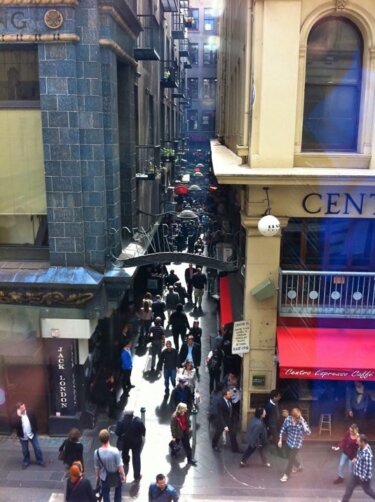How Melbourne transformed its tiny laneways into a pedestrian mecca
The Doable City Reader
There is so much that can be done to make our cities happier, healthier and more prosperous places. Every day in cities around the world, citizens and city planners alike are showing us how small actions can scale up to have massive impact. And they can in your city too.
That’s what the Doable City Reader is about. In June 2014, 8 80 Cities, in collaboration with the Knight Foundation, brought 200 civic innovators from around North America together in Chicago at the Doable City Forum to share and discover methods for rapid change making. The Doable City Reader is inspired by the rich conversations amongst presenters and participants at that forum. It is a resource for any and all people who want to make change in their cities and is meant to educate, inspire and empower anyone to do so.
Melbourne, Australia is home to one of the most renowned and vibrant street cultures in the world. But it wasn’t always like this. Up until the late 1980s, Melbourne suffered from the same ailment many North American cities grapple with today. Suburban growth had hollowed out the downtown core, leaving it a deserted no man’s land outside business hours. As famed city planner Jan Gehl once described it, “It was neutron-bombed, not a soul — not even a cat.”
The secret of the city’s rapid rebirth lies in the least expected of places: its unique grid of tiny, 10-metre-wide back alley laneways. While they exist in other cities (albeit usually wider), laneways are rarely considered viable public spaces. More often they are associated with garbage disposal and drug dealing than pedestrian culture.
But Melbourne saw its laneways as an opportunity for transformation and, throughout the 1990s, developed them into a rich network of intimate pedestrian-only thoroughfares lined with small restaurants, bars and shops. As a result, downtown Melbourne now boasts twice the number of evening pedestrians as it did in 1990, 12 times more outdoor cafes (in 1990 it had less than 50; now it has more than 600) and even, correspondingly, the highest ratio of street furniture per person in the world. Today Swanston Street draws more pedestrians per day than Regent Street in London.
A number of key policy changes led to Melbourne’s laneway revolution, including changes to the central business district that brought more jobs and permanent residents to the downtown core to frequent businesses; design rules prohibiting buildings from having long, blank facades, which led to more small-scale and diverse commercial spaces; and importantly, changes to the city’s liquor regulations that removed the requirement for bars to serve food and led to the creation of the considerably cheaper “small bar” licence. Melbourne’s laneways and inner-city streets hosted exactly the sort of small, low-cost spaces (originally the back of house for main street businesses) suited for these licences, which led to the proliferation of unique and offbeat niche venues.

Craig Allchin, a Melbourne architect and designer who opened one of Melbourne’s first and defining laneway bars on a lean $25,000 budget, notes that the most important thing the city did was reimagine what the otherwise barely-used spaces could be: a place for small-scale pedestrian life and experimentation.

It’s a notion that cities can transfer to other parts of the urban fabric, although, as Allchin notes in an interview with Broadsheet, “you can’t cut and paste a solution from one city to another because all cities have different morphologies and politics.” He notes that in Sydney, which doesn’t have the same laneway grid, they applied the same concept to unused basement spaces, an example of the type of creative adaptation necessary to transfer good ideas to different contexts.
“[Developers] travel the world and say, ‘We like the plaza in Copenhagen so we’ll take some of that; we like the pier in San Francisco and the pedestrian mall in Vienna and we’ll take some of those too; and we like the Melbourne laneways.’ They throw it all together on a master plan, hoping to create a quirky, hip and high-rent retail and pedestrian area. But the result doesn’t perform like any of the examples, and tends to feel like a regular mall, because it’s all under one ownership. The truth is, there is no absolute formula,” he says.
